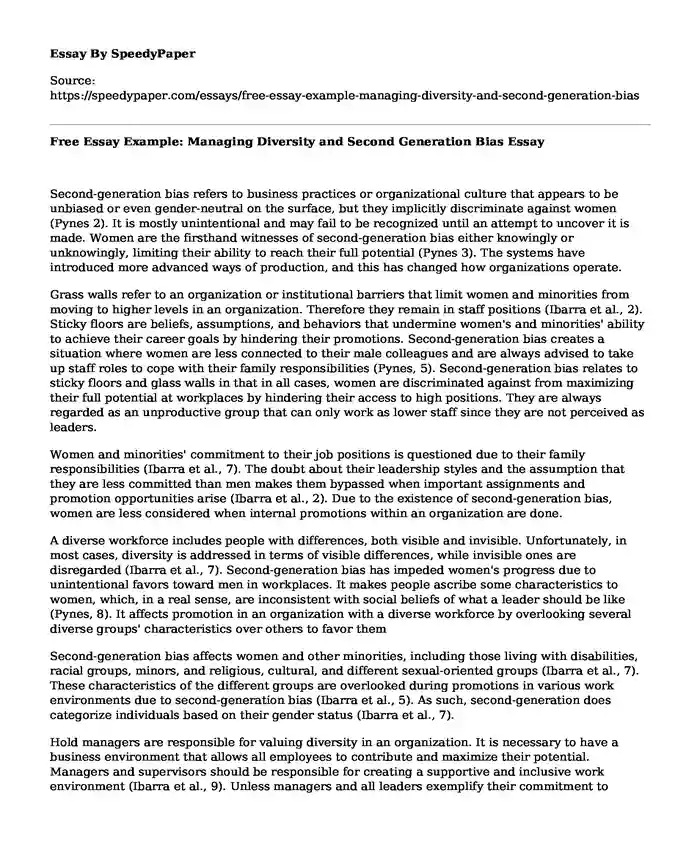
| Type of paper: | Essay |
| Categories: | Women Management |
| Pages: | 3 |
| Wordcount: | 571 words |
Second-generation bias refers to business practices or organizational culture that appears to be unbiased or even gender-neutral on the surface, but they implicitly discriminate against women (Pynes 2). It is mostly unintentional and may fail to be recognized until an attempt to uncover it is made. Women are the firsthand witnesses of second-generation bias either knowingly or unknowingly, limiting their ability to reach their full potential (Pynes 3). The systems have introduced more advanced ways of production, and this has changed how organizations operate.
Grass walls refer to an organization or institutional barriers that limit women and minorities from moving to higher levels in an organization. Therefore they remain in staff positions (Ibarra et al., 2). Sticky floors are beliefs, assumptions, and behaviors that undermine women's and minorities' ability to achieve their career goals by hindering their promotions. Second-generation bias creates a situation where women are less connected to their male colleagues and are always advised to take up staff roles to cope with their family responsibilities (Pynes, 5). Second-generation bias relates to sticky floors and glass walls in that in all cases, women are discriminated against from maximizing their full potential at workplaces by hindering their access to high positions. They are always regarded as an unproductive group that can only work as lower staff since they are not perceived as leaders.
Women and minorities' commitment to their job positions is questioned due to their family responsibilities (Ibarra et al., 7). The doubt about their leadership styles and the assumption that they are less committed than men makes them bypassed when important assignments and promotion opportunities arise (Ibarra et al., 2). Due to the existence of second-generation bias, women are less considered when internal promotions within an organization are done.
A diverse workforce includes people with differences, both visible and invisible. Unfortunately, in most cases, diversity is addressed in terms of visible differences, while invisible ones are disregarded (Ibarra et al., 7). Second-generation bias has impeded women's progress due to unintentional favors toward men in workplaces. It makes people ascribe some characteristics to women, which, in a real sense, are inconsistent with social beliefs of what a leader should be like (Pynes, 8). It affects promotion in an organization with a diverse workforce by overlooking several diverse groups' characteristics over others to favor them
Second-generation bias affects women and other minorities, including those living with disabilities, racial groups, minors, and religious, cultural, and different sexual-oriented groups (Ibarra et al., 7). These characteristics of the different groups are overlooked during promotions in various work environments due to second-generation bias (Ibarra et al., 5). As such, second-generation does categorize individuals based on their gender status (Ibarra et al., 7).
Hold managers are responsible for valuing diversity in an organization. It is necessary to have a business environment that allows all employees to contribute and maximize their potential. Managers and supervisors should be responsible for creating a supportive and inclusive work environment (Ibarra et al., 9). Unless managers and all leaders exemplify their commitment to diversity, the creation of an organizational culture that values diversity will not be successful (Ibarra et al., 8). There should be mission statements regarding how diversity is embraced and the provision of equal opportunities for all employees to maximize their potential.
Works Cited
Ibarra, Herminia, Robin Ely, and Deborah Kolb. "Women Rising: The Unseen Barriers." Harvard Business Review 91.9 (2013): 1-9.
Pynes, Joan E. Human Resources Management for Public and Nonprofit Organizations: A strategic approach. Vol. 30. John Wiley & Sons, 2013.
Cite this page
Free Essay Example: Managing Diversity and Second Generation Bias. (2023, Nov 10). Retrieved from https://speedypaper.net/essays/free-essay-example-managing-diversity-and-second-generation-bias
Request Removal
If you are the original author of this essay and no longer wish to have it published on the SpeedyPaper website, please click below to request its removal:
- How to Train Others at Work - HRM Essay Example
- Essay Example on Classroom Management Plan and Model Classroom
- Literature Review on Steve Jobs Personality, Essay Sample
- Close Betrayal - Free Essay Describing Personal Experience
- Free Essay with a Discussion of Staffing Concerns on Ethical Hiring Standards
- Free Essay: Effectiveness of Job Training in the Hotel Industry
- Women in Workplaces: Parenting a Challenge for Career Advancement - Essay Sample
Popular categories




